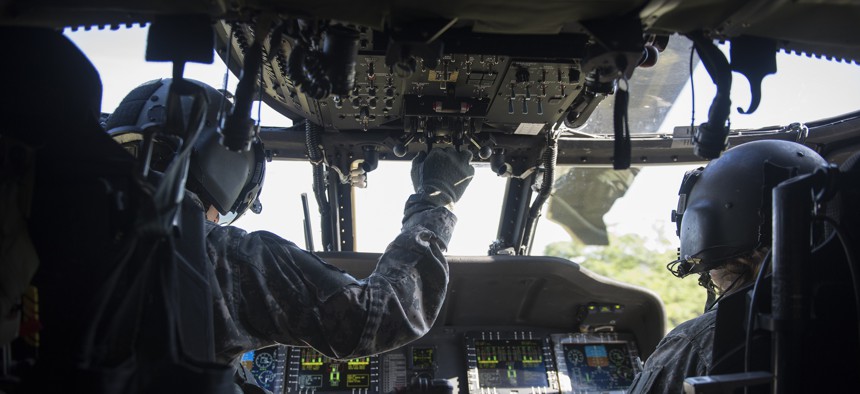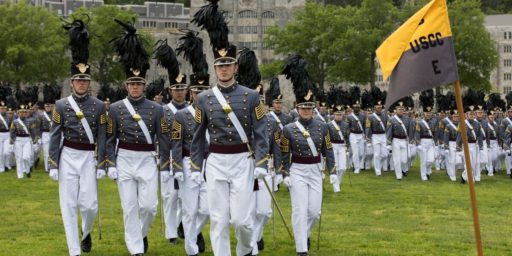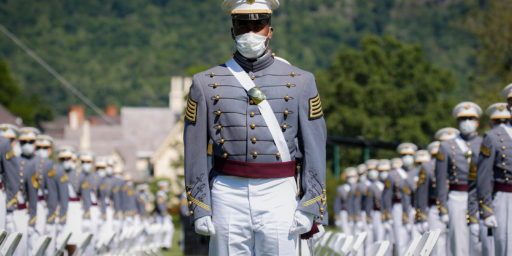Army Pilots Get Unexpected Extension
The personnel bureaucracy reinterpreted regulations.

NBC News (“Army aviators, ready to leave the military, are told they owe 3 more years instead“):
Hundreds of Army aviation officers who were set to leave the military are being held to another three years of service after they say the branch quietly reinterpreted part of their contract amid retention and recruitment issues.
The shift has sparked an uproar among the more than 600 affected active-duty commissioned officers, including some who say their plans to start families, launch businesses and begin their civilian lives have been suddenly derailed.
[…]
As part of a program known as BRADSO, cadets commissioning from the U.S. Military Academy or Army Cadet Command from 2008 and 2020 were able to request a branch of their choice, including aviation, by agreeing to serve an additional three years on active duty.
For years, the Army allowed some aviation officers to serve those three years concurrently, and not consecutively, along with their roughly contracted seven or eight years of service.
In a phone call with reporters Thursday, Army officials admitted “errors” in the system, which they noticed a few months ago, led to the discrepancy.
“We are fixing those errors, and we are in communication with the unit leadership and impacted officers,” said Lt. Gen. Douglas Stitt, deputy chief of staff of G-1, which is in charge of policy and personnel.
“Our overall goal to correct this issue is to provide predictability and stability for our soldiers while maintaining readiness across our force,” Stitt added.
In letters the Army sent this month to the affected aviators as well as to members of Congress, which were obtained by NBC News, it said it “realized” after conducting a “legal review of this policy” that the three-year BRADSO requirement has to be served separately.
“This is not a new policy, but we are correcting oversights in recordkeeping that led some officers with an applied BRADSO to separate from the U.S. Army before they were eligible,” the letter said.
Thursday’s media roundtable came after more than 140 aviation officers banded together to demand answers after learning one by one that they were being denied discharges due to outstanding BRADSO obligations beginning last fall.
More than 60 of them signed a letter to Congress outlining how they had been misled by the Army for years about the exact length of their service contract.
[…]
Documents obtained by NBC News show officers were given conflicting information about their service obligations.
In an email sent on Sept. 1, 2022, a career manager with the Army Human Resources Command told an officer that his service obligation runs concurrently. But when he sat down with a manager last week, he said he did not get that same clear answer.
“It’s demoralizing,” said the officer, who has been living apart from his wife for years because she could not relocate for work. “This isn’t the life we thought it was.”
[…]
Maj. Gen. Tom Drew, commander of Army Human Resources Command, told NBC News he would personally handle case-by-case reviews of officers who had planned milestones, such as weddings.
Every branch of the U.S. military struggled to meet its fiscal year 2022 recruiting goals, NBC News previously reported. The Army recruited 45,000 people last year, falling slightly short of its goal, Army Secretary Christine Wormuth said in March as officials launched a rebranding campaign to attract young people.
The affected officers believe these recruitment struggles, but mostly retention challenges, led the Army to review its BRADSO interpretation.
In 2020, the Army extended the length of service for new aviators from six years to at least a decade, citing increased costs and requirements for aircraft as the main reason.
Army Times (“Army’s about-face on contracts extends aviation officers’ service“) adds:
The chaos comes from the soldiers’ overlapping service obligations — agreements controlling when an officer can leave the Army — some of which are contract-based and some of which are set by federal law. Aviation officers have different requirements than those in other roles, adding to the confusion.
Dozens of impacted officers signed a letter to members of Congress claiming that officials fed them inaccurate information about their contract lengths. Among its enclosures, which Army Times obtained from multiple sources, were briefing materials and messages from branch managers, the Army’s official career advisors, that affirmed a shorter-length interpretation of their obligations.
The officers described service regulations and documents as filled “with contradicting statements,” and argued that the Army shouldn’t begin enforcing obligations that it didn’t on their peers who departed before the error was realized.
Maj. Gen. Tom Drew, Human Resources Command’s top general, argued that the contract form “clearly states” the longer commitment.
[…]
Drew acknowledged the “error” in calculating dates, but pushed back on the officers’ assertion that they did not have access to copies of their contracts.
Other than the handful with already approved resignations, pilots commissioned between 2015 and 2020 who signed such contracts must serve longer than expected due to the discovery. For those who were counting on a fast-approaching separation date and already made firm arrangements for civilian life, Drew said he would “personally” review and approve exception to policy requests waiving the additional years on a “case-by-case” basis.
[…]
Under the system the Army used for the last decade to match cadets with career fields, prospective officers ranked their desired jobs and indicated whether they’d accept an additional three-year contractual service obligation if necessary for them to get a branch of their choice.
Cadets signed the contracts, not knowing if the Army would even exercise them.
Then the Army branch selection board would weigh a cadet’s ranking alongside their willingness to accept an extra three years, according to methodology documents. Top-ranked cadets often received their favored choices without owing more time, but for a competitive branch like aviation, the board often selected average cadets who elected the additional service obligation.
For non-aviation officers, the math is simple. When their statutory commissioning service obligation ends, they serve their contractual three years. Non-aviation officers who incur any additional contractual obligations, such as one for military schooling, serve them concurrently after their commissioning obligation runs out. The officer can voluntarily resign after the completion of their longest-running contractual obligation.
For example, an engineer officer from West Point with the following commitments can still resign at the end of their eighth year, because their two contractual obligations run simultaneously:
- Five-year statutory commissioning obligation.
- Three-year contractual branch of choice obligation.
- Two-year contractual military course obligation for beginning a specialized development program at the start of year six.
Pilots, however, are the only Army officers who receive a second statutory obligation of six years when they finish flight school, thanks to a law passed during a late 1980s pilot shortage. A pilot with a contractual three-year “branch of choice” commitment thus cannot resign until at least three years after completing flight school, the Army has clarified.
Under Human Resources Command’s corrected application of laws and regulations, an ROTC scholarship aviation officer would not be able to resign until the end of their 11th year if they have the following commitments, assuming they graduate at the end of year two:
- Six-year statutory commissioning obligation.
- Six-year statutory flight school obligation that begins when the officer graduates at the end of their second year of service.
- Three-year contractual branch of choice obligation.
Previously,officials with Army Human Resources Command treated the flight school commitment as a contractual obligation, the letter said. That policy allowed officers to simultaneously serve it alongside their three-year branch of choice obligation and thus immediately resign six years after receiving their pilot’s wings, if they wished.
According to Drew, the reassessment came after officers commissioned in 2015 began to submit their resignations and his command realized their service obligation dates were incorrect.
“We went back and we did kind of audit all of those out there,” he said. The general cautioned that the service is still “refining” the number of officers, estimated at “a little over 600.” They now can’t leave immediately after finishing their flight school commitment.
While this strikes me as correcting a bureaucratic error rather than a cynical manipulation to force people to stay longer during a retention crisis, the effect is the same. These officers had been led to believe that they were eligible to resign from active duty six years after finishing flight school and now have been involuntarily extended for another three years.
The original interpretation of the regulations made no sense. The whole point of BRADSO was for the Army to gain an additional three years of service obligation from prospective officers in exchange for them getting their branch of choice rather than the one the Army assigned them. It’s a deal I would gladly have taken back in 1988 when the Army decided it needed me to be an artillery officer rather than an intelligence officer. Aviation has always been among the most competitive, if not the most competitive, accession branch.
Further, all of the military branches have historically had a difficult time retaining pilots. Their skills are coveted by the airlines, which pay considerably better and offer much more personal freedom. The Army, in particular, tends to force more senior aviator officers to spend most of their time out of the cockpit, seeing flying duty as something that junior officers and warrant officers do.
Because flight school is so long and expensive, it has long come with a longer payback tour than most other specialties. As noted in the NBC report, it has recently been extended from six years to ten–and that’s after two years of flight school. By that point, the Army is presumably betting most will just stay on to the twenty year mark for a pension.
In some ways, the whole concept is rather bizarre. We ask 17- and 18-year-old cadets to commit to five years or more of service right out of high school. And then we ask 21- and 22-year-olds about to be commissioned to add another three years on top of that in order to get their branch of choice. And, if that choice is aviation, we’re asking them to commit to two years of flight school, ten years of payback for school, plus the three years—taking them to 36 or 37 years old—before they’ve served one day in the real Army. And, of course, the commitment is unidirectional. The Army can decide they don’t need these officers at any point along the way.





I don’t think I understand. If you sign up for three “extra” years, how can this be discharged concurrently? Concurrently means not extra to me.
@Slugger: Agreed. Apparently, Big Army Personnel was counting flight school and the BRADSO commitment both as “contractual” obligations and thus allowed to count concurrently. But that obviously makes no sense. A handful (20ish) were allowed to retire under the previous interpretation and won’t be recalled. But the new interpretation strikes me as obviously correct.
I always find these military contract commitments interesting since they hark back to the time of indentures. Similarly with the sailing articles merchant seamen sign that commit them to the voyage, out and back to the same port. In the early 1600s, Maryland, etc. indentures weren’t well documented and eventually the courts set terminations, usually after an additional term of service. This was also the time when Africans with indentures found themselves declared slaves, such as John Casor in Virginia, when they sought enforcement of the end of their indentures.
Beyond service contracts, the US military has customs that can be traced back the Heptarchy time (between Rome and the formation of England) of werods, Old English for troop, company, army, that served the kings (giver of rings)
This is different in that outside government/military, an individual cannot be forced to perform a contracted service but can have a penalty imposed to make the person who relied on the promise whole. Well, at least until it came to baking cakes and photographing weddings in recent years.
Correcting this on a going-forward basis makes sense. Forcing people who signed up based on information they were given (even if wrong) to spend 3 more years in service that they don’t want to strikes me as terrible policy. If for morale reasons if nothing else (though morale problems like this-a feeling of betrayal-can lead to a whole host of other much more serious problems; best case you’re going to get apathy; worst is actual treason). And legally questionable to boot (even with the understanding the military law and civilian law don’t always align).
No question the counting is bizarre. I owed 4 years for medical school when I came on active duty. Internship incurred a year, so I owed 4 med school years and 1 training year. I spent 3 years in the fleet before starting residency, but the internship year was paid concurrently with a med school year, so I owed 1 med school year. After 3 years of residency I had incurred 3 training years plus that stubborn med school year. But again I paid the med school year concurrently with a training year from residency so after 3 years (10 years total on active duty after med school), I was done paying that all back. Ultimately I paid back 8 years of obligation over 10 years of active service, 4 of which I was in training, but without concurrent payback it would have taken me 12.
The earliest I could have been released from active duty would have been after 5 years if I’d done internship and then spent 4 years in the fleet, paying back the intern year concurrently with 4 years of med school